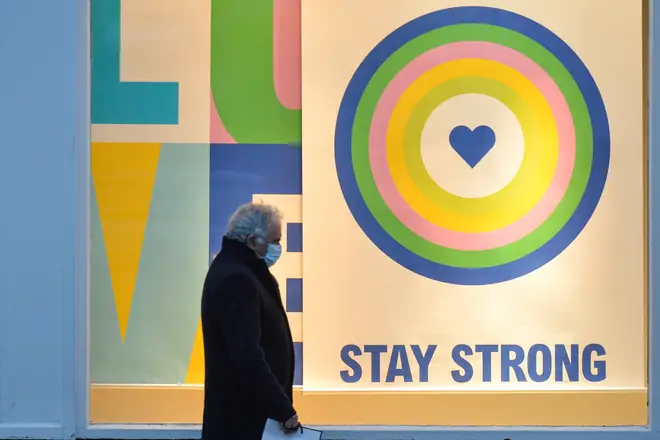
Tom Swarbrick 4pm - 6pm
12 February 2021, 13:39 | Updated: 12 February 2021, 14:15

The UK's Covid-19 R number has dropped below 1 for the first time since July and now stands between 0.7 and 0.9.
An R number between 0.7 and 0.9 means that, on average, every 10 people infected will pass on the virus to between seven and nine other people, which suggests the pandemic is shrinking.
This is a drop from last week when the R number stood between 0.7 and 1, according to the Scientific Advisory Group for Emergencies (Sage).
Latest figures also show that the number of new Covid infections is shrinking by between 2 per cent to 5 per cent every day, with the growth rate being between -2 and -5.
The Department for Health said in a statement: "We are confident the epidemic is shrinking across all NHS England regions.
"However, prevalence of the virus remains high, so it remains important that everyone continues to stay at home in order to keep the R value down, protect the NHS and help save lives."
Read more: PM to lay out roadmap for easing lockdown over coming months on 22 February
Read more: UK economy fell by 9.9% in 2020 - largest annual slump on record

Priti Patel says "should there be a need" the UK will share Covid jabs
It comes as new data from the Office for National Statistics (ONS) shows a drop in infections, with around one in 80 people in private households in England having the virus between 31 January and 6 February, the equivalent of 695,400 people.
This is down from around one in 65 people for the period between 24 and 30 January.
The data is based on swab results from people with and without symptoms.
On 9 February, the latest date for which figures are available, the number of patients in hospital with coronavirus in the UK stood at 25,621.
This is down 35 per cent from a peak of 39,236 on 18 January and is the lowest number since 29 December.
But while scientists advising the government believe cases of Covid-19 are dropping at a decent pace across England, they have warned that infection levels remain high.
Read more: Anthea Turner apologises after 'clumsy' Covid cartoon sparks backlash
Read more: Wales hits February vaccine target with over 684,000 given first dose

UK must not set a date for ending lockdown, GP tells LBC
Prime Minister Boris Johnson is facing calls from Tory sceptics to ease the lockdown once the pressure on the NHS eases and deaths drop.
But scientists argue that case numbers are still too high for a significant loosening of restrictions.
They believe that only by driving case numbers to much lower levels can NHS Test and Trace and surge testing work properly.
With low case numbers, clusters of cases can be identified more easily and new mutations to the virus can be picked up, one government scientific adviser said.
They argued that loosening restrictions when cases are low means there is less chance of R going above one, which leads to an exponential growth of the virus, and this creates a quicker path back to normal life.
The current halving time of the virus (the time it takes to the number of new infections to halve in size) is thought to be at around 14 to 17 days.

Virologist explains why Kent variant is 'on course to sweep the world'
Scientific advisers believe that if this continues, aided by the rollout of vaccines, then low case numbers can be achieved in the next two to three months.
Meanwhile, NHS England has said people aged 65 to 69 can now have a Covid-19 vaccine in England if GPs have done all they can to reach those at higher risk.
Some parts of England have already begun vaccinating the over-65s with their first dose after they reached everyone in the top four priority groups, including the over-70s and care home residents, who wanted a jab.
Nottinghamshire Clinical Commissioning Group is among those issuing invites, while in Shropshire, Coventry, York and Hampshire some vaccines have been given already.
NHS England said regions could now move on to people aged 65 and over if every effort has been made to contact and vaccinate those in groups one to four, and if there are supplies.
Once over-65s have been vaccinated, they will be officially followed by all those over 16 with underlying health conditions (group six), then the over-60s, the over-55s and the over-50s.
The Joint Committee on Vaccination and Immunisation (JCVI) is due to recommend which groups should then follow, with pressure for teachers and other frontline workers such as police officers to be on the list.
Some 17 per cent of people aged 60 to 69 and 14 per cent of those aged 50 to 59 in England have received their first vaccine dose, although it is unclear which priority group they fell into.
Listen & subscribe: Global Player | Apple Podcasts | Google Podcasts | Spotify